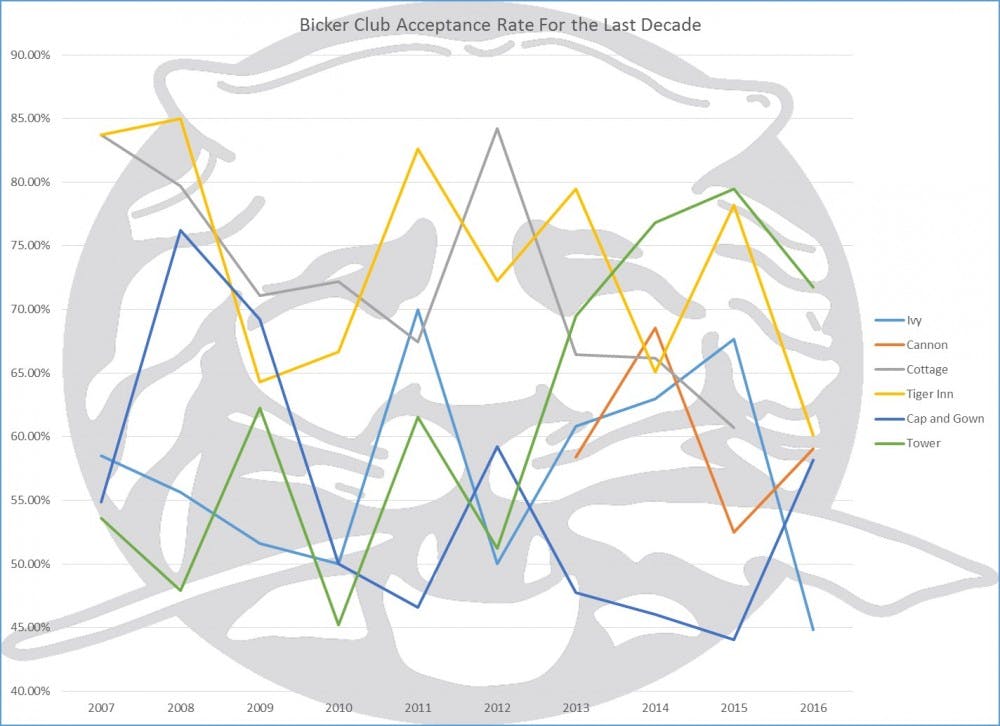952 members, or 72 percent, of the Class of 2019 joined either a selective or open eating club in the spring 2017 eating club admissions process, according to the official final statistics report from the Interclub Council of the Eating Clubs of Princeton University. Additionally, of the 105 juniors who registered on the ICC website, 32 joined selective clubs and 29 joined open clubs, the report states.
According to an ICC press release, these aggregated numbers come from an effort to “synchronize and improve the process of joining an eating club," as well as provide more information to students who are interested in joining.”
Furthermore, the ICC’s press release stresses an endeavor to “provide clear and accurate information about the clubs in order to encourage more students to explore the clubs, decrease the stress surrounding the process, and provide a more positive experience for students.”
Sophomores and juniors use the ICC website to manage the process of signing up to join clubs, visiting clubs, ranking club preferences, and receiving admission results. Final club announcements were made available this year at 9 a.m. on Feb. 10. If a student who bickered did not successfully make it into the club, they had the opportunity to sign in to an open non-Bicker club until Feb. 18.
ICC President Christopher Yu ’17 wrote in an email that the ICC does not release statistics for juniors in the Bicker and sign-in process.
“Since the number of juniors participating in the spring admissions process varies a lot year over year, and since the number is often very small, the ICC is not publishing these figures as they are not particularly meaningful/helpful,” he wrote.
This year, 416 sophomores elected to sign in to open clubs, constituting 40 percent of the Class of 2019’s participation in the Spring 2017 eating club admissions process, while 536 sophomores, 52 percent of those who registered with the ICC, joined selective clubs, the report notes. Ultimately, 8 percent of sophomores who took part in the admissions process were not placed in any eating club, the report adds. These statistics are consistent with the spring 2016 admissions process, in which 40 percent of sophomores registered on this site opted for membership in open clubs and 53 percent joined selective clubs.
The report also states that 28 percent of the participating junior class joined open clubs and 30 percent joined selective clubs this year. These rates demonstrate a contrast with spring 2016 admissions, which saw five percent of registered juniors seeking membership in open clubs and 38 percent joining selective ones.
Despite multiple requests, all of the old presidents of the Bicker or selective clubs have not released information on admission statistics beyond what the ICC has released, except for Tiger Inn and Tower Club, which provided their individual numbers for Bickerees and accepted members. The ICC does not release individual clubs’ numbers. In previous years, Bicker clubs provided this data to the ‘Prince.’
According to Yu, this change “represents a choice, not a policy change; the bicker clubs have always had the option to release the individual club bicker numbers or not.”
Graduate Interclub Advisor Lisa Schmucki ’74 supported Yu’s explanation in an email.
“In past years the clubs have always provided their individual numbers,” she wrote. “The ICC only issues numbers in aggregate, so we can’t help you with the individual club numbers. We feel that the individual clubs should give their own final numbers.”
As the administrator in charge of maintaining the clubs’ data, Schmucki said that the efforts to create an aggregate of the club numbers began in 2012, “when the clubs agreed to work together to run club admission together on one website — so we could protect the privacy of each club’s individual data.”
As for sign-in clubs, there was an imbalance in membership this year, with Terrace Club gaining the most new members. Terrace President Natalia Chen ’18 reported 137 new sophomore members along with 13 additional junior sign-ins. Matthew Lucas ’18, president of Colonial Club, noted 102 new members. Stefan Lee ’18, president of Quadrangle club, reported approximately 80 new sign-ins for the club. Charter Club president Elizabeth Stanley ’18 cited 67 new members. Finally, Allie Diamond ’18, Cloister Inn president, noted 50 new sign-ins.
In an email, Colonial president Lucas explained that the club’s numbers and those from the ICC may not match because a “handful of our sign-ins came from outside of the official university process.”
“We have chosen not to provide the exact numbers for early / late rounds because in truth the process is not as clear-cut as that,” Lucas explained in an email. “The lines between early and late rounds are blurred, so it is difficult to pin down an accurate number. All I can say is that a significant majority of our new members came from the first round of sign-ins.”
Quad president Lee declined to comment further, as did Cloister president Diamond, Terrace president Chen, and Charter president Stanley.





